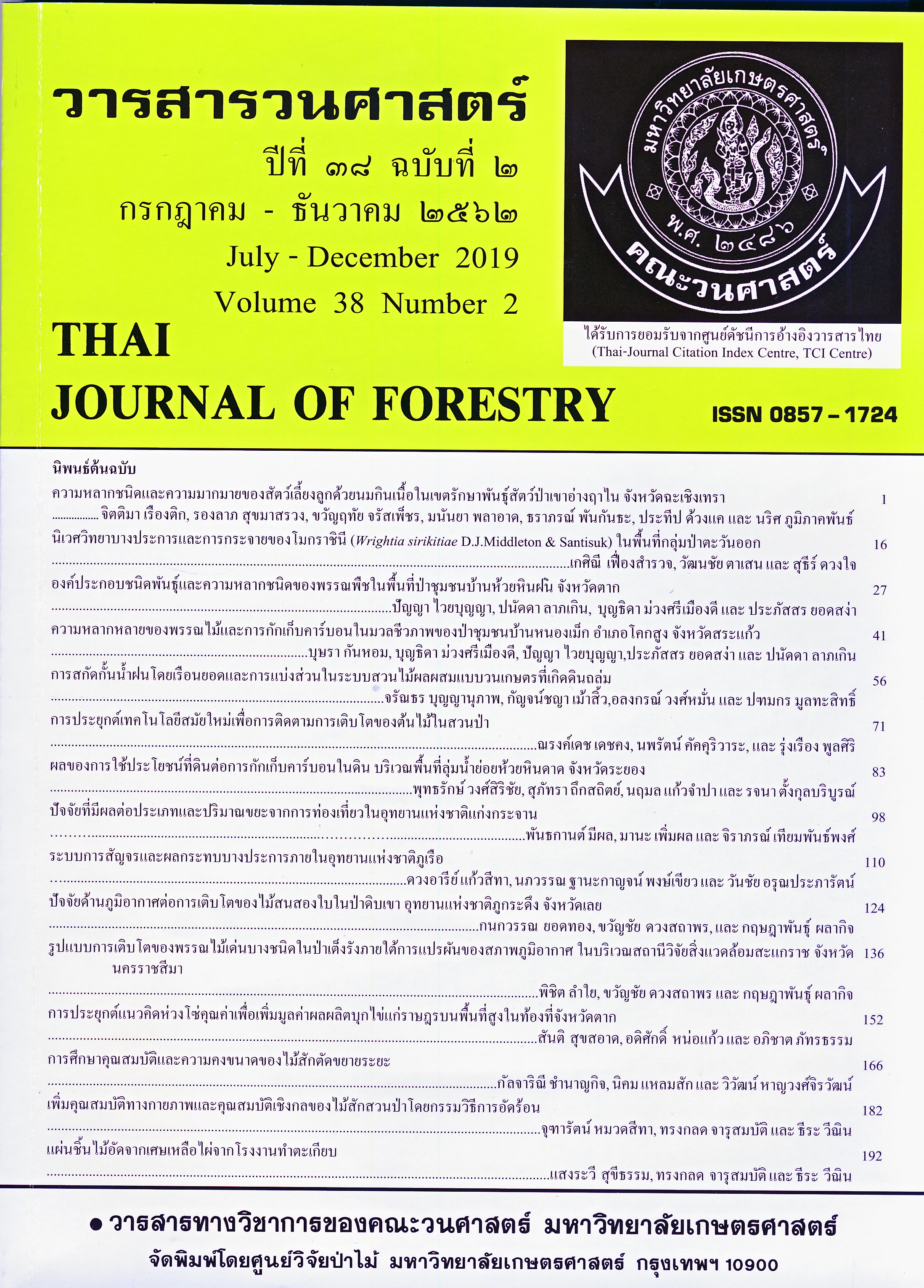การสกัดกั้นน้ำฝนโดยเรือนยอดและการแบ่งส่วนในระบบสวนไม้ผลผสม แบบวนเกษตรที่เกิดดินถล่ม
Main Article Content
บทคัดย่อ
การแบ่งส่วนของน้ำฝนโดยเรือนยอดพรรณไม้เป็นองค์ประกอบหลักของกระบวนการทางอุทกวิทยาที่มีความสัมพันธ์โดยตรงกับปริมาณน้ำฝนสุทธิ (net rainfall) ทั้งที่ตกลงบนพื้นผิวดินและซึมลงสู่ชั้นดิน การศึกษาครั้งนี้มีวัตถุประสงค์เพื่อเปรียบเทียบปริมาณการสกัดกั้นน้ำฝนโดยเรือนยอด และการแบ่งส่วนน้ำฝนระหว่างสวนไม้ผลผสมแบบวนเกษตรที่ไม่เกิดดินถล่ม (สถานการณ์ปกติ) และที่เกิดดินถล่มมาแล้ว 9 ปี ผลการศึกษา พบว่า ค่าเฉลี่ยของร้อยละน้ำฝนผ่านเรือนยอด น้ำไหลตามลำต้น และน้ำฝนที่ถูกสกัดกั้นโดยเรือนยอดมีความแตกต่างกันอย่างมีนัยสำคัญทางสถิติระหว่างสถานการณ์ปกติและสถานการณ์ที่เกิดดินถล่มมาแล้ว 9 ปี โดยภายใต้สวนไม้ผลผสมแบบวนเกษตร ต้นมังคุดมีค่าเฉลี่ยร้อยละของน้ำฝนที่ถูกสกัดกั้นโดยเรือนยอดสูงว่าพรรณไม้ชนิดอื่น (ร้อยละ 45.01 ของปริมาณน้ำฝนที่ตกแต่ละเหตุการณ์) รองลงมาได้แก่ ลองกอง (ร้อยละ 37.0) และทุเรียน (ร้อยละ 32.92) ตามลำดับ ขณะที่สถานการณ์ที่เกิดดินถล่มมาแล้ว 9 ปี พบว่า ต้นข้าวสารหลวงมีค่าเฉลี่ยร้อยละของน้ำฝนที่ถูกสกัดกั้นโดยเรือนยอดสูงกว่าต้นตองแตบ โดยมีค่าเท่ากับร้อยละ 34.41 และ 28.28 ตามลำดับ การแบ่งส่วนของน้ำฝนโดยเรือนยอดพรรณไม้เป็นองค์ประกอบพื้นฐานที่สำคัญอย่างมีนัยในเชิงอุทกวิทยาต่อการจัดการทรัพยากรน้ำสำหรับระบบนิเวศดังกล่าว
Downloads
Article Details
ข้าพเจ้าและผู้เขียนร่วม (ถ้ามี) ขอรับรองว่า ต้นฉบับที่เสนอมานี้ยังไม่เคยได้รับการตีพิมพ์และไม่ได้อยู่ในระหว่างกระบวนการพิจารณาตีพิมพ์ลงในวารสารหรือสิ่งตีพิมพ์อื่นใด ข้าพเจ้าและผู้เขียนร่วม (ถ้ามี) ยอมรับหลักเกณฑ์และเงื่อนไขการพิจารณาต้นฉบับ ทั้งยินยอมให้กองบรรณาธิการมีสิทธิ์พิจารณาและตรวจแก้ต้นฉบับได้ตามที่เห็นสมควร พร้อมนี้ขอมอบลิขสิทธิ์ผลงานที่ได้รับการตีพิมพ์ให้แก่วารสารวนศาสตร์ คณะวนศาสตร์ มหาวิทยาลัยเกษตรศาสตร์ กรณีมีการฟ้องร้องเรื่องการละเมิดลิขสิทธิ์เกี่ยวกับภาพ กราฟ ข้อความส่วนใดส่วนหนึ่ง หรือ ข้อคิดเห็นที่ปรากฏในผลงาน ให้เป็นความรับผิดชอบของข้าพเจ้าและผู้เขียนร่วม (ถ้ามี) แต่เพียงฝ่ายเดียว และหากข้าพเจ้าและผู้เขียนร่วม (ถ้ามี) ประสงค์ถอนบทความในระหว่างกระบวนการพิจารณาของทางวารสาร ข้าพเจ้าและผู้เขียนร่วม (ถ้ามี) ยินดีรับผิดชอบค่าใช้จ่ายทั้งหมดที่เกิดขึ้นในกระบวนการพิจารณาบทความนั้น”
เอกสารอ้างอิง
Boonyanuphap, J., P. Thonglem and L. Raksanok. 2016. Economic Valuation of Slope Stabilization Methods for Landslide Prevention in Maepoon Subdistrict: Its Implication on Payment for Ecosystem Services. Final
research report. The Chai Pattana Foundation, Bangkok. (in Thai)
Boonyanuphap, J., W. Punsak, O. Trithaveesak and L. Raksanok. 2017. Water Balance Evaluation in Upstream Ecosystems and Guideline for Public Participatory Water Resources Management under Climate Change and
Landslide. Final research report, Biodiversity- Based Economy Development Office (Public Organization), Bangkok. (in Thai)
Chunkao, K. and N. Tangtham. 1982. Practice Principles of Watershed Management. Department of Conservation, Faculty of Forestry, Kasetsart University, Bangkok. (in Thai)
Chunkao, K. and S. Ungkulpakdikul. 1971. Measurement of Throughfall in Hill Evergreen Forest, Dry Evergreen Forest, Teak Forest, and Deciduous Dipterocarp Forest of Thailand. Department of Conservation, Faculty of
Forestry, Kasetsart University, Bangkok. (in Thai)
Haaland, P.D. 1989. Experimental Design in Biotechnology. Marcel Dekker, Inc., NewYork.
Hu, R. 1999. Food Product Design: A Computer-Aided Statistical Approach. Technomic Publishing Co., Ltd., Pennsylvenia.
Jirasuktaveekul, W., P. Witthawatchutikul and S. Charoensuk. 1986. Rainfall Interception in Mixed Deciduous and Dry Dipterocarp Forest at Nan Watershed Research Station, Nan Province. Research Section, Watershed
Management Division, Royal Forest Department, Bangkok. (in Thai)
Kershaw, K.A. 1964. Quantitative and Dynamic Ecology. Edward, London.
Niyom, W. 1992. Forest Hydrology. Department of Conservation, Faculty of Forestry, Kasetsart University, Bangkok. (in Thai)
Witthawatchutikul, P. and S. Rouysungnern. 1983. Rainfall Interception of Fruit Tree in Rayong Province. Research Section, Watershed Management Division, Royal Forest Department, Bangkok. (in Thai)
Witthawatchutikul, P. 1985. Mangosteen and Rainfall. Research Section, Watershed Management Division,
Royal Forest Department, Bangkok. (in Thai)


